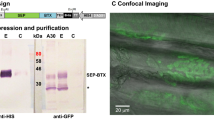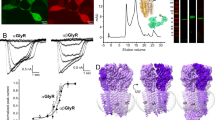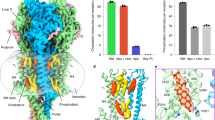Abstract
THE characterisation of glutamate receptors in nerve and muscle membranes requires compounds which interact specifically with these receptors. In the vertebrate central nervous system various substances are reported to act as agonists or antagonists of glutamate (reviewed in refs 1 and 2). At the locust and crustacean nerve-muscle junctions, where the receptors are readily accessible for biochemical and pharmacological characterisation, comparatively few compounds activate the glutamate-sensitive receptors or antagonise the excitatory action of glutamate3–9 and so such substances are needed. We report here that the glutamate analogue, DL-2-ammo-4-phosphonobuytyric acid (DL-APB) (Fig. 1), inhibits the binding of glutamate to ‘receptor-like’ hydrophobic proteolipids isolated from locust muscle10,11 and antagonises the excitatory action of glutamate applied iontophoretically to receptors present in the locust muscle membrane. The shape and charge distribution of DL-APB are appropriate for interaction with glutamate receptors2,7,12.
This is a preview of subscription content, access via your institution
Access options
Subscribe to this journal
Receive 51 print issues and online access
$199.00 per year
only $3.90 per issue
Buy this article
- Purchase on Springer Link
- Instant access to full article PDF
Prices may be subject to local taxes which are calculated during checkout
Similar content being viewed by others
References
Krnjević, K., Physiol Rev., 54, 418–540 (1974).
Buu, N. T., Puil, E., and van Gelder, N. M., Gen. Pharmac., 7, 5–14 (1976).
Lowagie, C., and Gerschenfeld, H. M., Nature, 248, 533–535 (1974).
Clements, A. N., and May, T. E., J. exp. Biol., 61, 421–442 (1974).
Shinozaki, H., and Shibuya, J., Neuropharmacology, 13, 665–672 (1974).
Lunt, G. G., in Insect Biochemistry and Function (edit. by Candy, D. J., and Kilby, B. A.), 283–305 (Chapman and Hall, London, 1975).
Usherwood, P. N. R., and Cull-Candy, S. G., in Insect Muscle (edit. by Usherwood, P. N. R.), 207–208 (Academic, New York and London, 1975).
Crawford, A. C., and McBurney, R. N., Proc. R. Soc., B 192, 481–489 (1976).
Anderson, C. R., Cull-Candy, S. G., and Miledi, R., Nature, 261, 151–153 (1976).
Lunt, G. G., Comp. gen. Pharmac., 4, 75–79 (1973).
James, R. W., Lunt, G. G., and Donnellan, J. F., Proc. 9th FEBS Mtg., 258 (Hung. Biochem. Soc., Budapest, 1974).
Curtis, D. R., and Watkins, J. C., J. Neurochem, 6, 117–141 (1960).
Cull-Candy, S. G., J. Physiol., Lond., 255, 449–464 (1976).
Dreyer, F., and Peper, K., Pflugers Arch., 348, 263–272 (1974).
Cull-Candy, S. G., and Usherwood, P. N. R., Nature new Biol., 246, 62–64 (1973).
Castillo, J. del, and Katz, B., Proc. R. Soc., B 146, 339–356 (1957).
Katz, B., and Miledi, R., J. Physiol., Lond., 170, 379–388 (1964).
Feltz, A., and Mallart, A., J. Physiol., Lond., 218, 85–100 (1971).
Author information
Authors and Affiliations
Rights and permissions
About this article
Cite this article
CULL-CANDY, S., DONNELLAN, J., JAMES, R. et al. 2-Amino-4-phosphonobutyric acid as a glutamate antagonist on locust muscle. Nature 262, 408–409 (1976). https://doi.org/10.1038/262408a0
Received:
Accepted:
Published:
Issue Date:
DOI: https://doi.org/10.1038/262408a0
This article is cited by
-
Inhibitory glutamate receptor channels
Molecular Neurobiology (1996)
-
Asymmetric synthesis of heteroorganic analogs of natural products. 6. (S)-?-amino-?-phosphonocarboxylic acids
Bulletin of the Russian Academy of Sciences Division of Chemical Science (1992)
-
New phosphonic analogs of aspartic and glutamic acid by aminoalkylation of trivalent phosphorus chlorides with ethyl acetyloacetate or ethyl levulinate and benzyl carbamate
Monatshefte für Chemie - Chemical Monthly (1982)
Comments
By submitting a comment you agree to abide by our Terms and Community Guidelines. If you find something abusive or that does not comply with our terms or guidelines please flag it as inappropriate.



